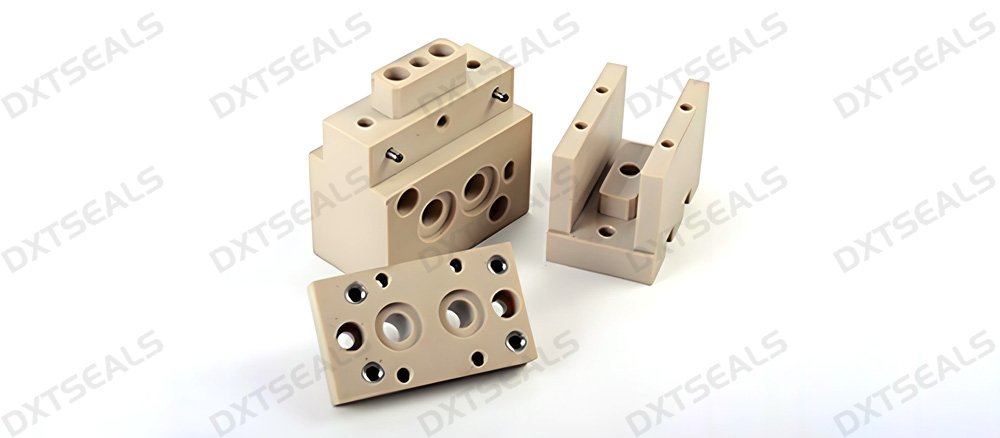Introduction
The aerospace industry demands high-performance materials that can withstand extreme temperatures, high mechanical stresses, and aggressive chemical exposure while maintaining lightweight and durable characteristics. Polyetheretherketone (PEEK) has emerged as a leading material in aerospace engineering due to its exceptional strength-to-weight ratio, heat resistance, and chemical stability.
This article explores why PEEK is the ideal choice for aerospace components, its key advantages, and its applications in modern aircraft and spacecraft.
1. Why PEEK is the Best Material for Aerospace Components
1.1 Lightweight yet Strong
- PEEK provides an exceptional strength-to-weight ratio, making it stronger than many traditional plastics while remaining much lighter than metals like aluminum and titanium.
- Its lightweight properties contribute to fuel efficiency and reduced carbon emissions, making it an ideal choice for modern aerospace designs.
1.2 High-Temperature Resistance
- PEEK can withstand temperatures up to 260°C (500°F) without losing its mechanical properties.
- Unlike traditional thermoplastics, PEEK does not soften or degrade under high thermal stress, making it ideal for engine components and high-heat environments.
1.3 Superior Chemical and Corrosion Resistance
- Aerospace components are exposed to jet fuels, hydraulic fluids, de-icing chemicals, and cleaning solvents.
- PEEK resists chemical degradation, ensuring long-lasting performance in harsh operating conditions.
1.4 Exceptional Wear and Friction Resistance
- PEEK has a naturally low coefficient of friction, making it an excellent material for bearings, bushings, and wear-resistant components.
- It minimizes friction and wear, extending the lifespan of aerospace parts while reducing maintenance costs.
1.5 Flame and Smoke Resistance
- PEEK is inherently flame-retardant, with low smoke and toxic gas emissions.
- It meets FAA and aerospace safety regulations, ensuring passenger and crew safety in case of fire.
2. Key Aerospace Applications of PEEK
2.1 Aircraft Structural Components
- Interior panels, seat frames, and brackets
- Provides high strength without adding excessive weight
- Enhances fuel efficiency and payload capacity
2.2 Engine Components
- Compressor seals, fuel system components, and thermal insulators
- Withstands high temperatures and chemical exposure
- Reduces engine wear and enhances performance
2.3 Electrical and Electronic Systems
- Cable insulation, connectors, and sensor housings
- Excellent electrical insulation and EMI shielding properties
- Ensures reliable operation in extreme environments
2.4 Bearings, Bushings, and Wear-Resistant Parts
- Landing gear bushings, thrust washers, and valve seats
- Reduces friction and maintenance requirements
- Extends operational lifespan of critical components
2.5 Spacecraft and Satellite Applications
- Thermal insulation components, structural supports, and lightweight fasteners
- Functions in vacuum conditions and extreme temperature variations
- Offers radiation resistance for long-term space missions
3. PEEK vs. Traditional Aerospace Materials
| Property | PEEK | Aluminum | Titanium | Carbon Fiber |
|---|---|---|---|---|
| Weight | Light | Medium | Heavy | Light |
| Strength | High | High | Very High | Moderate |
| Temperature Resistance | 260°C (500°F) | 660°C (1220°F) | 1668°C (3034°F) | 200°C (392°F) |
| Chemical Resistance | Excellent | Moderate | Excellent | Moderate |
| Wear Resistance | High | Low | High | Moderate |
| Machinability | Easy to Machine | Moderate | Difficult | Difficult |
✔ PEEK offers a balance of lightweight, strength, and durability, making it a competitive alternative to metals in non-structural aerospace applications.
4. The Future of PEEK in Aerospace Engineering
As the aerospace industry moves towards more fuel-efficient, lightweight, and environmentally friendly solutions, PEEK continues to gain traction due to its:
✅ Exceptional performance under extreme conditions
✅ Weight reduction leading to lower fuel consumption
✅ Improved durability and reduced maintenance
✅ Versatility in both commercial and military aircraft
With advancements in 3D printing and composite materials, PEEK’s role in aerospace applications is set to expand further, driving innovation and efficiency in aircraft design.
Conclusion: Why PEEK is the Ideal Choice for Aerospace Components
PEEK is revolutionizing aerospace engineering by offering:
✔ Lightweight yet high-strength performance
✔ Heat resistance up to 260°C (500°F)
✔ Superior chemical and corrosion resistance
✔ Flame retardancy and low smoke emissions
✔ Wear resistance for extended component life
For aircraft manufacturers, aerospace engineers, and space exploration projects, PEEK delivers unmatched performance, efficiency, and safety, making it a key material for the future of aviation and space travel.

